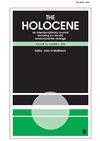高精度湖泊沉积物年表的放射性碳采样工作
IF 1.8
3区 地球科学
Q3 GEOGRAPHY, PHYSICAL
引用次数: 1
摘要
具有最佳时间控制的高分辨率年表是将古环境研究与独立的高精度历史、考古或气候数据进行比较的关键。精确的年表对于十年到百年时间尺度的古记录的站点间比较也是至关重要的。我们提供了一份来自瑞士低地一个经过充分研究的小型湖泊Burgäschisee的最新沉积物年表。新的年龄-深度关系是使用从Burgäscheee沉积物中提取的大量陆地植物遗骸的新放射性碳样本和贝叶斯年龄-深度模型生成的。结果显示,2σ的不确定性仅为±19 青铜时代早期(3800年 cal.BP)至中世纪早期(1150 cal.BP)。四种年龄深度建模技术(贝叶斯和非贝叶斯)之间的差异很小(约25 年),并在较低的放射性碳日期可用性下保持稳定。先前公布的初步年表与Burgäschisee的精细年表之间的最大年龄偏移为225岁 年。我们的结果证明了严格的二次采样策略的重要性,该策略包括仔细选择最好的陆地植物材料,并尽可能避免放射性碳校准平台。Burgäschisee的新年表现在可以与该地区的考古、历史和其他古生态证据进行更准确的现场对比。本文章由计算机程序翻译,如有差异,请以英文原文为准。
Radiocarbon sampling efforts for high-precision lake sediment chronologies
High-resolution chronologies with the best time control are key for comparing palaeoenvironmental studies with independent high-precision historical, archaeological or climatic data. Precise chronologies are also essential for inter-site comparisons of palaeo records at decadal to centennial time scales. We present an updated sediment chronology from Burgäschisee, a small and well-studied lake in the Swiss lowlands. The new age-depth relationship was generated using a large number of new radiocarbon samples of terrestrial plant remains extracted from the Burgäschisee sediments and Bayesian age-depth modelling. The results reveal 2σ uncertainties of only ±19 years for the entire record covering the Early Bronze Age (3800 cal. BP) to the Early Middle Ages (1150 cal. BP). The differences between four age-depth modelling techniques (Bayesian and non-Bayesian) are minor (around 25 years) and remain stable with lower radiocarbon date availability. The maximum age offset between the preliminary previously published and the refined chronology from Burgäschisee is 225 years. Our results demonstrate the importance of a rigorous subsampling strategy that includes a careful selection of the best terrestrial plant material and avoiding radiocarbon calibration plateaus whenever possible. The new chronology from Burgäschisee now allows a more accurate site-to-site comparison with archaeological, historical and other palaeoecological evidence from the region.
求助全文
通过发布文献求助,成功后即可免费获取论文全文。
去求助
来源期刊

Holocene
地学-地球科学综合
CiteScore
4.70
自引率
8.30%
发文量
106
审稿时长
4 months
期刊介绍:
The Holocene is a high impact, peer-reviewed journal dedicated to fundamental scientific research at the interface between the long Quaternary record and the natural and human-induced environmental processes operating at the Earth''s surface today. The Holocene emphasizes environmental change over the last ca 11 700 years.
 求助内容:
求助内容: 应助结果提醒方式:
应助结果提醒方式:


